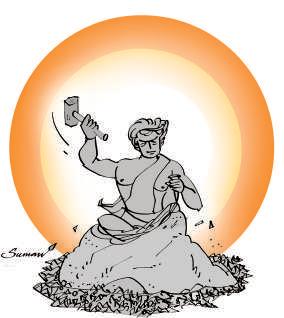
I had first heard of this village - let us call it VP not in connection with its multilingual population, but in connection with its community bank that the villagers managed. When I visited the village, I found that almost all families were into farming. The youth studied and then did farming in the village. But just like everywhere else, farming did not pay them enough. Every few years they would need some extra income. So, all youths in the village went outside for a few years ranging from two to five and earned money working as manual labourers. They went to the Andaman Islands and also abroad to Singapore and Malaysia. They were largely employed in laying - roads in these countries. Back in the village with the extra money, they would use it to repair their old houses, buy two-wheelers, conduct family weddings, or repay long-pending loans.
I found out why the youth came back after a few years. VP is a beautiful village with many kanmai (traditional ponds in the village are called kanmai in southern Tamil Nadu), on the foothills of the eastern ghat mountains. It is very clean and will any day qualify as a picture postcard village. At the entrance to the village is a peepal tree, which marks the village boundary. The villagers have not allowed political parties to cross this tree and enter the village for their campaigns for a long time! Party representatives speak to village elders sitting under the tree and then take leave. I am aware of some other villages too that have a similar norm in dealing with outsiders, particularly politicians.
This story is from the August 2022 edition of The Vedanta Kesari.
Start your 7-day Magzter GOLD free trial to access thousands of curated premium stories, and 9,000+ magazines and newspapers.
Already a subscriber ? Sign In
This story is from the August 2022 edition of The Vedanta Kesari.
Start your 7-day Magzter GOLD free trial to access thousands of curated premium stories, and 9,000+ magazines and newspapers.
Already a subscriber? Sign In

Panchakroshi Parikrama of Varanasi
At the snow-capped Kailas, the Divine Lord Shiva was seated with Mother Parvati.

Gadai and the Monks
A fictional narrative based on incidents from the childhood of Sri Ramakrishna.

Chintayo momo maanosho Hori...
Sri Ramakrishna loved songs. There probably was no normal day when he did not sing some songs.

The Vedanta Vaccine
The world is still struggling under the impact of the pandemic due to Covid-19 for the last three years.

Chandrakirti's Chariot: Self in Madhyamaka Buddhism and Advaita Vedanta
The goal in Advaita Vedanta is the cessation of suffering and the attainment of true fulfillment. Suffering, according to this school, is due to ignorance of the true nature of the self and consequent erroneous identification with the body-mind.

Reminiscences of Sargachhi
Question: यद्यदाचरतत श्रेष्ठसतत्तदरेवरेतरो जनिः। ‘Whatever a superior person does, others do the same thing!’ (Gita 3:21) – What does this statement mean?

THE AUTUMN FESTIVAL
A fictional narrative based on incidents from the childhood of Sri Ramakrishna.

Bards of Guruvayur: Vilwamangalam II
Saints of India

In the Universal Mother’s Divine Playground
Swami Vivekananda never taught the worship of Mother Kali. In a letter to Mary Hale he writes, “Kali worship is not a necessary step in any religion.

Swami Vivekananda: A Sportsman Par Excellence
In various books and articles, Swami Vivekananda has been called a spiritual leader, a prophet, a patriot, a social reformer, a philosopher, a yogi, a writer, an orator, an educationist, a musician, and so on.